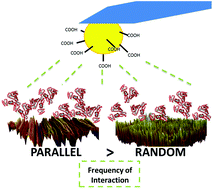Adsorption and adhesion of common serum proteins to nanotextured gallium nitride†
Abstract
As the broader effort towards device and material miniaturization progresses in all fields, it becomes increasingly important to understand the implications of working with functional structures that approach the size scale of molecules, particularly when considering biological systems. It is well known that thin films and nanostructures feature different optical, electrical, and mechanical properties from their bulk composites; however, interactions taking place at the interface between nanomaterials and their surroundings are less understood. Here, we explore interactions between common serum proteins – serum albumin, fibrinogen, and immunoglobulin G – and a nanotextured gallium nitride surface. Atomic force microscopy with a carboxyl-terminated colloid tip is used to probe the ‘activity’ of proteins adsorbed onto the surface, including both the accessibility of the terminal amine to the tip as well as the potential for protein extension. By evaluating the frequency of tip–protein interactions, we can establish differences in protein behaviour on the basis of both the surface roughness as well as morphology, providing an assessment of the role of surface texture in dictating protein–surface interactions. Unidirectional surface features – either the half-unit cell steppes of as-grown GaN or those produced by mechanical polishing – appear to promote protein accessibility, with a higher frequency of protein extension events taking place on these surfaces when compared with less ordered surface features. Development of a full understanding of the factors influencing surface–biomolecule interactions can pave the way for specific surface modification to tailor the bio-material interface, offering a new path for device optimization.


 Please wait while we load your content...
Please wait while we load your content...